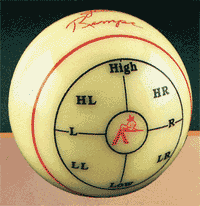I had this happen to me once too many times!
That is attempting to draw the cue ball a specific distance and not being able do it, then losing a game because of this.
So I decided to do something about it! I didn't care how much it cost or how long it took to solve this problem.
One of the problems seemed to be with the tip on my cue. I was listening to the locals [bad] advice about tip care and that was to "tip tap" my tip. When I did this, I would get good draw for awhile, then as I used the tip, it would get worse and worse. So I was going from good draw to poor draw with my tip. My tip was not consistent.
So I decided to try out many different tips and see what worked best. I read all I could about the subject and tried different tips myself. I also tried different tip shapes and shaft sizes.
To make a long story short, I found that a dime shaped Moori Q (hard) tip would work best for draw shots *and* all other shots required in a game. And the bigger the better. Max size for a dime shape is 12.75 mm shaft size at tip. (Larger and curve goes down to ferrule.)
So Moori Q dime shaped tip and 12.75 mm shaft size at tip. This gets the best draw, keeps its tip shape the longest (hard tip) and was consistent with wear. (I later learned that a dime shape is recommended for my Predator shaft.)
Then I needed to keep the tip surface consistent. I was able to do this with a sandpaper shaper. I made my own dime shaped tip shaping tool. I purchased a section of 1/2 inch electrical PVC pipe and cut a piece about 8 inches long and then cut that in half. Then I cut a piece of 220 grit sandpaper about 1 inch wide and 8 inches long, then hold it in the inside curve of the half PVC. Then sand back and forth while slowly rotating my cue. Here is a picture of my PVC tip shapers (different sizes - dime, nickel, quarter) last picture at bottom...
http://www.geocities.com/billybobnospam/pr.html
I now lightly sand (resurface) my tip after about every 4 hours of play or before a tournament. So what I have now is a consistent tip shape (dime), a consistent tip (always Moori Q), and a consistent tip surface (lightly sand after every 4 hours of play). (I need a new tip about every 6 months, but so what? The money I win in tournaments more than pays for this small expense.)
So bingo! I am now always playing with a tip which is always in the *same* condition! BIG help on the road to shooting consistent draw shots - drawing back a specific distance that is.
Next I learned about chalking. Not chalking before each draw shot can cause trouble. It is *very* important to chalk well before each and every draw shot especially around the sides of the tip. (Before every other shot as well.) After chalking, hold your tip up to the light and be sure there are no dark spots around the side. If there are, apply more chalk or sand if needed. If the ball scoops (jumps), it is a "not enough chalk/slick tip" problem usually.
So now I always had the same tip and same amount of chalk applied. My tip would always work the same.
Next was myself. I practiced drawing the cue ball back different distances. I set up a line of balls between the center pockets and placed the cue ball one diamond back. I practice drawing the cue ball back one diamond, then two diamonds, then 3, etc.
And I have practiced doing this everyday for several years. And I will say that I am now pretty good at drawing the cue ball back just a little (6 inches) or more (2 diamonds), half a table, or all the way back. I can do this at will.
Note that I can go and grab a house cue with a cruddy tip on it - slick as can be. Well my "drawing skills" go out the window when I use such a cue. Sure I can draw the cue ball back. But I can't use extreme (very low on ball) draw because I will scoop the ball. So I have less of a range of up/down with my draw shots when using a cruddy tip. And no telling how far back I will be able to draw the ball back when using a cruddy tip. This is because the house cue tip is *different* from the tip I have learned to draw accurately with.
I can alter the drawing distance by how low I hit the ball (training ball 1, 2, 3, 4, etc.), how much I follow through, and speed of hit.
So how do I alter the amount of drawback I get these days? I don't really know what I am doing because it is "automatic". I just am able to do it. I think I use a combination of all three depending on how far the cue ball is away from the object ball.
Anyway if you always shoot with the same exact tip with the same surface condition and chalk, then you can practice drawing back the cue ball different distances daily for a few years and get to be quite good at drawing back a specific distance.
If you are playing with different brands/hardness tips, different tip shapes, tips with different surface conditions, and not applying chalk well to the sides before each shot, then I think it would be quite difficult to learn to draw back specific distances each time every time.

